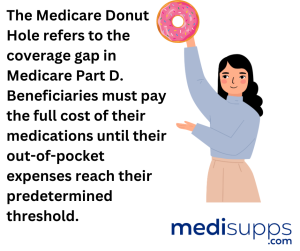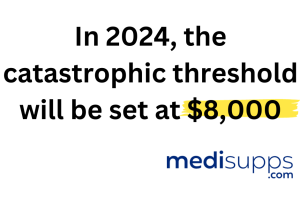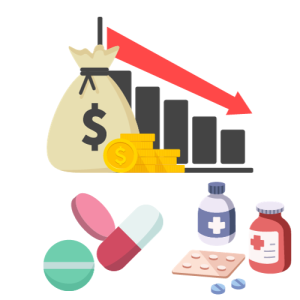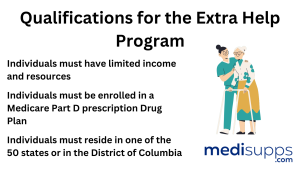
by Russell Noga | Updated September 14th, 2023
 In recent years, the Medicare Donut Hole has been a source of confusion and financial strain for many beneficiaries. But what if we told you that significant changes are on the horizon?
In recent years, the Medicare Donut Hole has been a source of confusion and financial strain for many beneficiaries. But what if we told you that significant changes are on the horizon?
In this article, we’ll explore the reforms taking place in 2024 and 2025, which promise to alleviate out-of-pocket costs and improve access to medications for Medicare recipients. One key question on everyone’s mind is, “is the Medicare Donut Hole going away in 2024?”
Get ready to dive into the world of Medicare and discover how these changes will affect you and your loved ones.
Short Summary
- The Medicare Donut Hole is being gradually phased out, with reforms planned for 2024 and 2025 to reduce prescription drug costs.
- In 2024, the 5% coinsurance requirement in Part D will be eliminated and manufacturers required to provide a 10% discount off brand-name drugs starting in 2025.
- Strategies such as enrolling in Extra Help program, using generic drugs or considering Medicare Advantage plans can help manage prescription drug costs.
Understanding the Medicare Donut Hole
The Medicare Donut Hole, or coverage gap, has long been a thorn in the side of beneficiaries, causing a temporary halt in coverage that forces them to pay full price for prescription drugs. Understanding the intricacies of this complex system is vital to navigating the challenges posed by out-of-pocket costs.
In the following sections, we’ll demystify the Medicare Donut Hole by explaining its very nature and breaking down the four key phases of Medicare Part D coverage.
 What is the Medicare Donut Hole?
What is the Medicare Donut Hole?
The Medicare Donut Hole refers to a coverage gap in Medicare Part D, a program designed to help beneficiaries afford their prescription drugs.
During this gap, beneficiaries must shoulder the full cost of their medications until their out-of-pocket expenses reach a predetermined threshold, at which point catastrophic coverage kicks in. Historically, this gap left many Medicare recipients in a precarious position, struggling to afford their medications and maintain their health.
Thankfully, progress has been made in recent years to close the Donut Hole. By 2019, the gap had been phased out for brand-name drugs, and by 2020, it was eliminated for generic drugs as well. As a result, beneficiaries now pay only 25% of the cost for both brand and generic drugs during the coverage gap phase.
The Four Phases of Medicare Part D
To better understand the Medicare Donut Hole, it’s crucial to recognize the four phases of Medicare Part D coverage: Deductible, Initial Coverage, Donut Hole, and Catastrophic Coverage.
During the Deductible phase, beneficiaries are responsible for paying the full cost of their prescription drugs until they reach their annual deductible amount. Once the deductible is met, the Initial Coverage phase begins, in which beneficiaries pay a copayment or coinsurance for their prescription drugs up to the initial coverage limit.
The Donut Hole phase, as previously discussed, is when beneficiaries pay a higher coinsurance rate for their prescription drugs until they reach the out-of-pocket threshold.
Finally, the Catastrophic Coverage phase comes into play, where beneficiaries pay a reduced amount (5% of the cost of covered drugs or $4.15 for generic drugs or $10.35 for brand-name drugs in 2023, whichever is greater) until the end of the year.
Discover 2024 Plans & Rates
Enter Zip Code
Changes to the Medicare Donut Hole in 2024
With changes on the horizon for the Medicare Donut Hole in 2024, it’s crucial to stay informed and understand how these updates will impact you. In the upcoming sections, we’ll delve into the elimination of the 5% coinsurance and its implications for out-of-pocket costs.
Further reforms are planned for 2025, and we’ll discuss those in detail as well.
Elimination of the 5% Coinsurance
In 2024, the 5% coinsurance requirement in the Medicare Part D catastrophic phase will be abolished. This means that beneficiaries will no longer be responsible for paying 5% of the cost of their medications during this phase.
Instead, the catastrophic threshold for 2024 will be set at $8,000, providing a clear limit on out-of-pocket expenses for beneficiaries.
Starting in 2025, drug manufacturers will be required to provide a 10% discount off the price of their brand-name drugs during the initial coverage phase. This changes the current 70% price discount available during the coverage gap phase. This will further help to lower out-of-pocket costs for Medicare beneficiaries and improve access to necessary medications.
Impact on Out-of-Pocket Costs
The changes coming to the Medicare Donut Hole in 2024 and 2025 will have a profound impact on out-of-pocket costs for beneficiaries. The elimination of the 5% coinsurance requirement in the catastrophic phase will lead to significant savings for Part D enrollees who require high-cost medications covered by Part D.
Additionally, the introduction of the $2,000 out-of-pocket cap in 2025 will limit beneficiaries’ spending under the Medicare Part D benefit, ensuring that they will no longer have any out-of-pocket costs once the catastrophic threshold is reached.
These changes will not only reduce the financial burden for Medicare beneficiaries, but also enhance affordability, leading to improved medication adherence and better health outcomes.
In short, these upcoming reforms hold the potential to transform the lives of millions of Medicare recipients, providing much-needed relief from the high costs of prescription drugs.
 Further Reforms in 2025
Further Reforms in 2025
As we look beyond 2024, additional Medicare reforms are on the horizon for 2025, promising even more benefits for beneficiaries. In the following sections, we will explore the introduction of the $2,000 out-of-pocket cap and the smoothing option for monthly installments, both of which offer further relief from the financial challenges of prescription drug costs.
The $2,000 out-of-pocket cap will limit the amount of money a person can spend.
Introduction of the $2,000 Out-of-Pocket Cap
In 2025, a significant reform will take effect with the introduction of the $2,000 out-of-pocket cap for Medicare Part D prescription drug costs. This cap will provide a clear limit on the amount beneficiaries are required to spend on their medications under the Medicare Part D benefit.
After paying the initial deductible, a person on Medicare will pay 25% of drug costs until they reach the catastrophic threshold, which will be set at $8,000 in 2024. Once this threshold is reached, beneficiaries will no longer have any out-of-pocket costs.
This new cap will not only help to reduce the financial burden for Medicare beneficiaries, but also improve access to medications, ensuring that individuals can obtain the treatments they need without worrying about excessive costs.
Smoothing Option for Monthly Installments
Another notable reform coming in 2025 is the smoothing option for monthly installments, which will provide Medicare beneficiaries with the flexibility to spread out-of-pocket prescription drug costs over a series of monthly payments.
By offering a more manageable payment schedule, the smoothing option will ease the financial strain for beneficiaries and make it easier to budget for prescription drug expenses.
To take advantage of the smoothing option, beneficiaries will simply need to make monthly payments for the remainder of the plan year. This innovative solution can especially benefit those who face high out-of-pocket costs for their medications, making it more feasible to access and adhere to vital treatments.
How These Changes Affect Medicare Beneficiaries
Now that we have explored the various changes coming to the Medicare Donut Hole and their implications, it’s important to consider the overall impact of these reforms on Medicare beneficiaries.
In the sections below, we will examine how these changes will result in lower prescription drug costs and improved access to medications for millions of individuals.
The Donut Hole is a gap in Medicare Part D coverage that requires beneficiaries to pay for the Donut Hole.
Lower Prescription Drug Costs
The changes coming to the Medicare Donut Hole in 2024 and 2025 are expected to significantly reduce prescription drug costs for Medicare beneficiaries. The Inflation Reduction Act of 2022 has established provisions to decrease the cost of prescription drugs for those with Medicare and reduce drug spending by the federal government.
The act has also limited Medicare Part D out-of-pocket drug costs and capped insulin copays, making medications more accessible and affordable for beneficiaries.
These changes will provide substantial relief for Medicare recipients, helping them save money on their prescription medications and ensuring they can access the treatments they need without worrying about excessive costs. This, in turn, will lead to better health outcomes and overall well-being for millions of individuals.
Improved Access to Medications
The Medicare reforms happening in 2024 and 2025 will not only lower prescription drug costs but also improve access to medications for beneficiaries.
By eliminating the 5% coinsurance requirement, introducing the $2,000 out-of-pocket cap, and offering the smoothing option for monthly installments, these changes will alleviate the financial burden for Medicare recipients and make it easier to obtain necessary medications.
Improved access to medications will undoubtedly lead to better medication adherence, which is crucial for managing chronic conditions and maintaining overall health. With these changes, Medicare beneficiaries can look forward to a future where they can access the medications they need without worrying about financial strain.
Strategies to Manage Prescription Drug Costs
While the upcoming changes to the Medicare Donut Hole will undoubtedly provide relief for many beneficiaries, it’s still essential to explore strategies for managing prescription drug costs.
In the following sections, we will discuss the Extra Help program, using generic drugs, and considering Medicare Advantage plans as ways to further reduce the financial burden of medications.
Extra Help Program
The Extra Help program is a valuable resource for Medicare beneficiaries who need additional financial assistance with their prescription drug coverage costs. This program helps lower or eliminate Part D costs for eligible individuals, covering premiums, deductibles, and coinsurance.
To qualify for the Extra Help program, individuals must have limited income and resources, be enrolled in a Medicare Part D prescription drug plan, and reside in one of the 50 states or the District of Columbia.
By offering financial support to those who need it most, the Extra Help program plays a vital role in ensuring that all Medicare beneficiaries can access the medications they need without being overwhelmed by out-of-pocket costs.

Generic Drugs
One of the most effective ways to reduce prescription drug costs is by utilizing generic drugs. These medications contain the same active ingredients and offer the same therapeutic effects as their brand-name counterparts, but are typically sold at a lower cost.
Generic drugs are subject to rigorous testing and must meet the same quality and safety standards as brand-name drugs, ensuring that they are both effective and safe to use.
By choosing generic drugs over brand-name medications, Medicare beneficiaries can significantly reduce their out-of-pocket costs while still maintaining the same level of treatment effectiveness. This cost-saving strategy can make a significant difference in managing the financial burden of prescription drug expenses.
Medicare Advantage Plans
Medicare Advantage plans offer another alternative for managing prescription drug costs. These plans, offered by private companies approved by Medicare, provide coverage for both Part A and Part B benefits and may also include additional benefits such as prescription drug coverage, dental services, and Medicaid services.
By considering Medicare Advantage plans as an alternative to traditional Medicare, beneficiaries can access additional coverage options and potentially lower their prescription drug costs. This can result in better overall health outcomes and improved financial stability for those who choose to enroll in these plans.
Compare Medicare Plans & Rates in Your Area
Summary
In conclusion, the upcoming reforms to the Medicare Donut Hole hold the potential to greatly benefit Medicare beneficiaries by reducing out-of-pocket costs and improving access to medications.

By staying informed about these changes and exploring strategies such as the Extra Help program, generic drugs, and Medicare Advantage plans, individuals can take control of their prescription drug expenses and maintain their health without being overwhelmed by financial strain.
Together, we can look forward to a brighter future where access to vital medications is no longer a barrier to optimal health and well-being.
Compare 2024 Plans & Rates
Enter Zip Code
Frequently Asked Questions
What is the Medicare Donut Hole?
The Medicare Donut Hole, officially known as the Medicare Part D coverage gap, is a phase within the Medicare prescription drug benefit where beneficiaries have to pay more for their medications after reaching a certain spending threshold.
Is the Medicare Donut Hole going away in 2024?
No, the Medicare Donut Hole is not going away in 2024. It was phased out gradually through the Affordable Care Act (ACA) and was completely eliminated by 2020. There are no plans to reinstate it.
What changes should Medicare beneficiaries expect in 2024?
While the Donut Hole won’t return, Medicare beneficiaries may see changes in premiums, deductibles, and coverage for specific medications. These changes are usually announced annually by the Centers for Medicare & Medicaid Services (CMS).
What was the purpose of the Medicare Donut Hole?
The Medicare Donut Hole aimed to reduce the government’s financial burden and encourage beneficiaries to choose lower-cost medications by requiring them to pay a larger share of their prescription drug costs within this coverage gap.
How did the Affordable Care Act affect the Medicare Donut Hole?
The ACA gradually closed the Donut Hole by reducing the beneficiary’s share of drug costs while they are in the coverage gap until it was completely eliminated in 2020.
Are there any assistance programs to help with prescription drug costs under Medicare?
Yes, programs like Extra Help (Low-Income Subsidy) provide assistance to low-income Medicare beneficiaries, helping them cover their prescription drug costs even after the Donut Hole closure.
What should Medicare beneficiaries do if they face high prescription drug costs?
If beneficiaries experience high prescription drug costs, they can explore options like switching to lower-cost medications, enrolling in a Medicare Advantage plan with drug coverage, or seeking financial assistance programs.
Are there any proposed changes to Medicare drug coverage in the near future?
Medicare drug coverage can be subject to legislative changes, but as of my last knowledge update in September 2021, there were no immediate plans to reintroduce the Donut Hole or make significant changes to Part D coverage.
How can beneficiaries stay informed about Medicare changes?
Beneficiaries should regularly review their Annual Notice of Change (ANOC) and Evidence of Coverage (EOC) documents, consult with Medicare counselors, or visit the official Medicare website for the latest updates on plan changes and coverage.
Does the Donut Hole affect all Medicare Part D plans in the same way?
No, the Donut Hole impact can vary among different Part D plans. The specific costs and coverage within the Donut Hole may differ depending on the plan chosen by the beneficiary. It’s important to compare plans and choose one that aligns with your medication needs and budget.
Find the Right Medicare Plan for You
Finding a Medicare plan shouldn’t have to be stressful. Whether it’s a Medigap plan or you have questions about Medicare Advantage or Medicare Part D, we can help.
Call us today at 1-888-891-0229, and one of our knowledgeable, licensed insurance agents will be happy to assist you!



